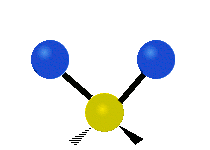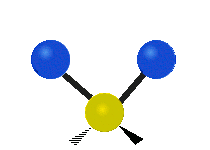Stretching vibration
The stretching vibration is a term from the field of molecular spectroscopy . It is a special molecular vibration in which the distances ( bond lengths ) of the individual atoms in the molecule change, which is why it is also known as stretching vibration . The vibration occurs along the core connection line. The energy required for this is usually transmitted by radiation with a wave number between 500 and 4,000 cm −1 .
The stretching vibration must be distinguished from the deformation vibration .
| Wave number in cm −1 | Molecular group | Sample materials | Intensity for the sample materials |
|---|---|---|---|
| 3200 ... 3750 | -OH | Alcohols , water | strong, broad |
| 3300 ... 3500 | -N-H | Amines , amides | wide |
| 3300 | ≡C – H | Alkynes | strong |
| 3000 ... 3100 | = C-H | aromatic rings , alkenes | medium |
| 2800 ... 3000 | -C-H | Aliphatic hydrocarbons , -CH 3 , -CH 2 | strong |
| 2500 ... 3000 | -OH | Carboxylic acids | strong |
| 2150 ... 2260 | –C≡C | Alkynes | varying |
| 2210 ... 2260 | –C≡N | Nitriles | medium |
| 1670… 1800 | -C = O | Carbonyl compounds ( ketones , ...) | strong |
| 1640 ... 1680 | -C = C | Alkenes | medium |
| 1560, 1350 | -NO 2 | Nitro groups | strong |
| 1180 ... 1360 | -C-N | Amines | medium |
| 1100 | –C – O – C– | Ether | strong |
| 1000 ... 1150 | -C-O | Alcohols | strong |
| 1000 ... 1400 | -C-F | Fluoroalkanes | strong |
| 600 ... 800 | -C-Cl | Chloroalkanes | strong |
| 500 ... 600 | -C-Br | Bromoalkanes | strong |
| 500 | -C-I | Iodoalkanes | strong |
The indicated wave numbers correspond to the approximate position of the corresponding peaks . These can also differ slightly due to other influencing factors.
Individual evidence
- ↑ a b Entry on IR spectroscopy. In: Römpp Online . Georg Thieme Verlag, accessed on October 13, 2013.
- ↑ Paula Yurkanis Bruice: Organic Chemistry . 5th edition, Pearson Education Inc., 2007, ISBN 978-3-8273-7190-4 , p. 611.

